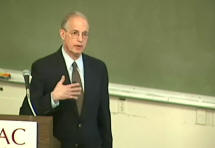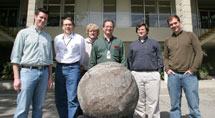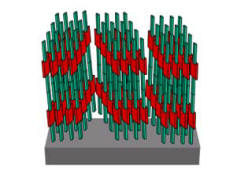
Living the "I" of the ILC
It's Happening
Right Here at SLAC
It’s a small pre-enactment of things to come when the International Linear Collider (ILC) is built: an international collaboration spending all hours of the day and night in the control room and the experimental hall, working with an high-energy beam with bunches each comprised of 20 billion electrons and of length roughly equal to ten times the diameter of a human hair (namely about 300 microns).
Forty physicists from 15 institutions are participating in a two-week run, completing today, for ILC beam tests at the End Station A facility here at SLAC. The physicists are testing prototypes that are needed for the ILC machine to measure and help maintain the high quality of beams of electrons and positrons just before they collide with each other in the interaction region of the ILC. The collaborators come from England, the U.S., Germany and Japan and they are represented just as strongly by university researchers as by laboratory researchers.
To make these tests realistic and useful, the researchers need a beam which has the challenging bunch parameters needed for the ILC. There is only one place in the world where that is possible: here at SLAC. The unique SLAC electron beam is transported faithfully to End Station A, where a mature user facility, ideally suited to efficient and effective testing, exists. Thus in the space of only two weeks, a large variety of experimental tests can be achieved.
One such experiment is testing the effectiveness of collimators. Collimators are metal jaws with a small gap which are placed in the path of the beam to shave off stray electrons that would otherwise cause unacceptable backgrounds in particle detectors. Eight sets of collimators of different shapes and materials are being tested to understand what they do to the core of the electron beam. These devices are critical for acceptable operation at the ILC; however, if improperly designed and implemented, the collimators can have deleterious consequences on the key parameters of the beam, and thereby on the required performance of the ILC.
A second experiment is testing a prototype ILC energy spectrometer. Two such spectrometers are needed to measure the energies separately of the electron and positron beams at the very challenging precision of one part per ten-thousand. The ILC will need such precision energy measurements to determine the exact mass of particles produced at the ILC, such as the long-sought Higgs.
Two other studies are for a) a prototype beam position monitor for the ILC Linac and b) diagnostics for measuring the bunch length. Both these developments also have applicability for LCLS. Read more...
|
Harold Shapiro's Talk Available Onlineby Chandra Shekhar

Click here
to view a Real Media file of Shapiro's talk.
If you are a SLAC employee and do not have Real Media Player installed on
your machine, you can download it
here.
Particle physics is on the threshold of major scientific discoveries, but unless the United States takes prompt action, it risks being left out.
This was the message of Harold Shapiro, acclaimed economist and chairman of the National Academies Committee on Elementary Particle Physics in the 21st Century (EPP2010).
"Particle physics is at a crossroads," he told a lecture audience of approximately 300 at the Panofsky Auditorium on Friday.
Read more...
SLAC Welcomes
New Employees

SLAC welcomed six new employees last Thursday. From left to right, they are:
Gregory Stewart (Tech Pubs), Abraham Wheeler (Library), Tony Beukers (Controls
and Power Electronics), Ernie Grome (Environment, Safety and Health),
Christopher Melton (Main Control Center), and Ben Steinwand (Scientific
Computing and Computing Services).
It's Pief's Birthday!by Lesley Wolf
 It is that time of year again to celebrate the force of nature known as Pief. It is that time of year again to celebrate the force of nature known as Pief.
W.K.H. Panofsky, the first director of SLAC, is now 87 years young. We warmly invite you and your colleagues to join us in a birthday celebration Tuesday, May 9 from 2:00 - 3:00
p.m. in the Panofsky Auditorium Breezeway. Please let others know about this event. For more information, please contact
Ellie Lwin or
Lesley Wolf.
Electrical Safety Tip:
What Makes Safety Glasses Safe?by the Electrical Safety Committee
 Unlike regular glasses, safety glasses are
made of clear, hard plastic and have side and top covers. Unlike regular glasses, safety glasses are
made of clear, hard plastic and have side and top covers.
Safety glasses are used to protect the eye from many kinds of hazards, including
electrical arcs; dust, concrete, metal and other particles; chemicals such as acids, bases, fuels, solvents, lime and cement powder;
falling or shifting debris, building materials and glass; smoke and noxious or poisonous gases;
welding light; and thermal hazards and fires.
Personal eyeglasses, unless specifically designed, are not adequate to use as safety glasses. Please take the time to use safety glasses—it's not worth the risk.
|
Lab Announcements
Community Bulletin Board
|






 <%
Response.AddHeader "Last-modified", getArticleDate()
'Response.AddHeader "Last-modified","Mon, 01 Sep 1997 01:03:33 GMT"
'Monday, December 06, 2010
%>
<%
Response.AddHeader "Last-modified", getArticleDate()
'Response.AddHeader "Last-modified","Mon, 01 Sep 1997 01:03:33 GMT"
'Monday, December 06, 2010
%>